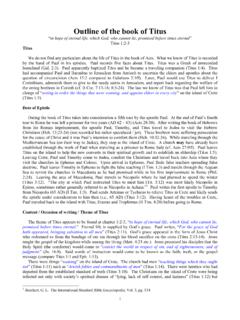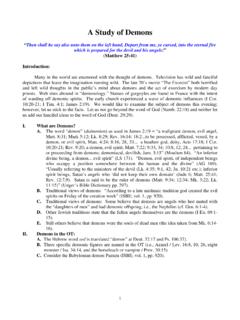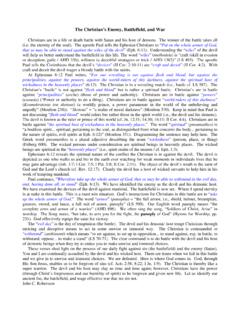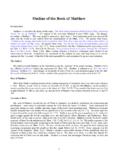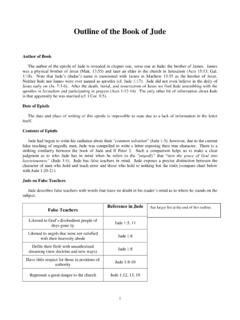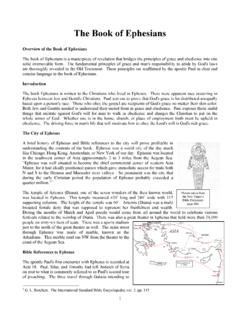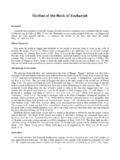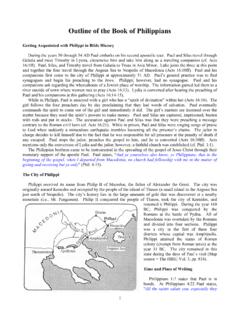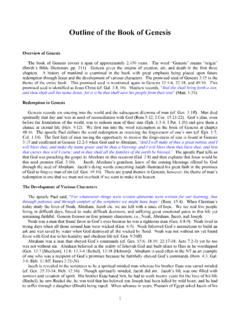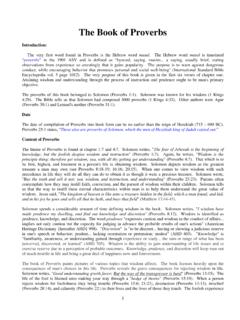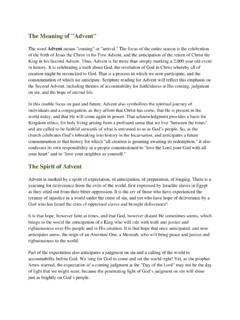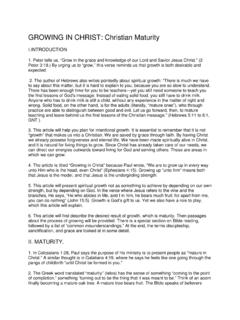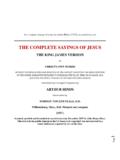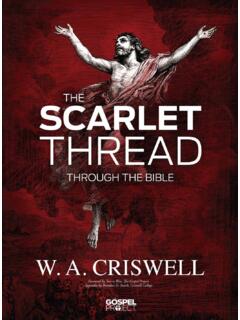Transcription of Outline of the Book of John - Floral Heights Church of Christ
1 1 Outline of the Book of John Introduction: The thesis of the entire book of John may fairly be placed on John 20:30-31: Many other signs therefore did Jesus in the presence of the disciples, which are not written in this book: but these are written, that ye may believe that Jesus is the Christ , the Son of God; and that believing ye may have life in his name. It has been said that the gospel of John is somewhat like a tract. Its aim is to bring its readers to a faith in Jesus Christ and prove, unequivocally, that He is the Son of God. The book is, therefore, separated from what is commonly referred to as the Synoptic Gospels (Matthew, Mark and Luke). These are synoptic in the sense that they are similar in content, order and statement. For example, outside the events of Passion Week and the Resurrection period, the fourth Gospel touches the Synoptic narrative in only one incident, that of the Feeding of the Five Thousand and the walking on the water.
2 1 While the Synoptic Gospels concentrate on the Galilean, Perean and Judean ministry, John speaks at length of the time Jesus spent preaching in Jerusalem. One more distinguishing fact regarding the Gospel of John is that it does not deal with the parables of Jesus, as do the Synoptic Gospels. What strikes us as odd, while studying the book of John, is that the account of the Lord s Supper is left out of his narrative. These facts stand as evidence that John had a different purpose in his writing than did the synoptic writers. Eusebius records that John, having been shown the other Gospels, testified to their truth, but admitted that they lacked a record of the events of the early days of Christ s ministry before John the Baptist was imprisoned. 2 As stated above, it appears that John has a spiritual purpose behind his writing, which is indicated by John 20:30-31. His testimony of Christ is given in hope of saving his readers from the current errors being taught of his day.
3 This may be more accurately explained after examining the time in which John wrote this account of the life of Christ . Ephesus, being near to Colossi, was subject to the false teaching of Gnosticism, Docetism and Asceticism. Forty years earlier (AD 55), Paul had dealt with a heresy of Asceticism mixed with Gnosticism at Colossi (Col. 2:20-23). One Gnostic belief was that Simon Peter died on the cross in the place of Jesus. Docetism preached that Jesus never really became incarnate. They maintain that Christ could never have been contaminated by the world, since it was essentially evil. This meant that Christ did not really become flesh. 3 Another faction that had reared its head in Ephesus was that some held that John the Baptist was the Messiah. For this cause some knew only the baptism of John (Acts 18:24-28). Paul came in contact with twelve of these individuals in Acts 19:1-7. As John would have seen these heresies first hand, he determined to write an account of the life of Christ that illustrated proof that Jesus was the Son of God and that he was God in the flesh, deity.
4 Secondly, unlike the Synoptic Gospels, John clearly shows the preparatory work of John the Baptist and does not grandees him at all. To the contrary, John emphasizes the subordinate function of John the baptizer (Jn. 1:19-28). Time of Writing Domitian was Emperor of Rome when John was exiled to the island of Patmos. Evidently John refused to bow down and worship the emperor. The consequence was that he was secluded from society for punishment. Domitian died in AD 96 at which time John was released from his exile. John returns to Ephesus and there he writes his gospel probably around 97 or 98 AD. Secular historians, such as Eusebius, support these thoughts. Author of the Book of John The author of the Gospel according to John can be none other than the apostle John, one of the sons of Zebedee and Salome (Matt. 27:56). John had a special relationship to Jesus: 1 A.
5 T. Robertson s Word Pictures in the NT Volume V pg. Xiv. 2 Daniel H. King; Truth Commentaries on John pg. Xxxix. 3 Ibid. pg. Liv. 2A. He was at first a disciple of John the Baptist (Jn. 1:35-42). B. John is often referred to as the disciple whom Jesus loved (Jn. 21:7). C. The one who leaned on the breast of Jesus at the Supper (Jn. 13:23). D. One of only three who saw Jesus raise up the daughter of Jairus (Mark 5:37; Luke 8:51). E. One of only three to see Jesus transfigured (Matt. 17:1ff). F. He took care of Jesus mother after the crucifixion (Jn. 19:25-27). G. He was the only apostle present when the Lord was crucified (Matt. 26:56). H. He was first to the tomb upon hearing the news that Jesus had been resurrected from the dead (Jn. 20:2). I. After the Church was established he suffered persecution and imprisonment (Acts 4:3 and 5:17-42). J. John the apostle was regarded as a pillar in the Church in Jerusalem (Acts 15:6-13). Jesus regarded John as one of the sons of thunder (Mark 3:17).
6 This does not mean that John was boisterous in speech, crude of manners or tempestuous in disposition; it was assigned to him because it reflected the courage and conviction he felt and his willingness to lay the axe at the root of the tree when duty demanded. Though gentle and kind he was not a weakling and his positive convictions gave him constancy and courage to face up to any situation confronting him. He was a son of thunder in teaching the truth, in opposing error, in challenging the enemies of the Lord; qualities and characteristics the Lord approved and appreciated 4 (see study # 1; God s Desired Character). The Seven signs of Jesus recorded in the Book of John: I. Jesus turns the water into wine at Cana (Jn. 2:1ff). II. Jesus heals the nobleman s son (Jn. 4:46-54). III. Jesus heals a man that had been lame for 38 years near the pool of Bethesda (Jn. 5:2-9). IV. Jesus feeds the five thousand with five loaves and two fishes (Jn.)
7 6:1-15). V. Jesus walks on the Sea of Galilee (Jn. 6:16-21). VI. Jesus heals a blind man by spitting in the dirt and making clay then applying the mud to the blind man s eyes (Jn. 9:1-7). VII. Jesus raises Lazarus from the dead (Jn. 11:17ff). The I am s of Jesus: I. I am the bread of life (Jn. 6:35). II. I am the light of the world (Jn. 8:12). III. I am the door of the sheep (way of entering salvation) (Jn. 10:7-9). IV. I am the good shepherd (10:11). V. I am the resurrection and the life (11:25). VI. I am the way (Jn. 14:6). VII. I am the truth (Jn. 14:6). VIII. I am the life (Jn. 14:6). Special Studies in John: I. The deity of Jesus in John A. Jesus is the Word that was God (1:1). B. Jesus had a part in creating the world (1:2). C. Jesus, as the Word, became flesh (1:14, 29-30). D. Nathanael confesses the deity of Christ (1:49). E. Jesus performed faith producing signs and many believed that He was deity (2:1-11, 23). F. Jesus reveals His deity to the Samaritan woman at Jacob s well (4:26).
8 G. The Samaritans confess the deity of Jesus (4:39-42). 4 Guy N. Woods; New Testament Commentaries (The Gospel Advocate Series) pg. 13-14. 3H. Jesus was equal with God (Jn. 5:18). I. Jesus is the divine King that was foretold of coming in the OT (Jn. 1:49; 6:14-15). J. Jesus never sinned (Jn. 8:46). K. Jesus is the great I Am (Jn. 8:58) (see all I am statements in John). L. Martha confesses the deity of Jesus (Jn. 11:27). M. John quotes from Isa. 6:10 and 53:1 and makes the application of God to Jesus thus proving His deity (Jn. 12:38-40). N. Jesus proclaims the oneness between He and the Father to Philip (Jn. 14:8ff). O. The disciples confess the deity of Jesus in the upper room after the Passover Feast meal (Jn. 16:30). P. Thomas proclaims the deity of Jesus (Jn. 20:28). II. Jesus professes His deity: A. To the Samaritan woman (Jn. 4:26). B. To the unbelieving Jews (Jn. 8:58; 10:24, 25, 30). C. To the blind man that was healed (Jn.)
9 9:37). D. To Philip (Jn. 14:8ff). E. To Caiaphas the high priest (Mk. 14:62). F. To Pilate (Jn. 18:37). III. Jesus preaches the terms of admission into the eternal kingdom of God A. Jesus preached to Nicodemus instructions that he may enter into the kingdom of God (3:3). Nicodemus was told to be born anew (cause to exist). This can only occur through hearing gospel preached, believing message, confessing that Jesus is the Christ , repenting of sins, being baptized for the remission of sins, and living faithfully to the Lord (cf. notes at John 3:1ff). B. Believing in Jesus (3:15-18, 36; 11:25-26). C. Obeying gospel message (cf. Jn. 7:37-39; 8:51). D. Jesus is the one and only way to heaven (14:2-6). Peter clearly understood this (Jn. 6:67-68). IV. John on believing in Jesus A. Belief equates to eternal life (3:14-16; 6:40, 47, 67-68; 11:25-26). B. Belief equated to obeying the Son (His words) (3:36). C. Hearing (adhering) to the words of Jesus is equated to belief (4:24; 8:47; 9:31) whereas not hearing is equated to unbelief (Jn.
10 8:43-45; 9:27). D. Abiding in the word of God is equated to believing Jesus (5:38). E. Unbelief equals dieing in your sins (8:24). F. Jesus winnows those who lay claims to belief and faith (Jn. 2:23-25; 6:2, 15; 7:31-32, 40-44; 8:30; 10:40-42). G. Unbelief is equated to sin (Jn. 16:8-9). H. Belief is produced by revelation (Jn. 20:30-31). V. The consequences of exposing men s sins: A. Those who are spiritually darkened hate the light of the gospel because it exposes their dark deeds (3:19-20). B. Those who represent truth, as Jesus, are persecuted by the world (5:14-18). C. The world hates those who expose their dark deeds (7:7). D. The world hates those who are not like them (Jn. 15:18-25). VI. Truth can and must be known: A. Knowing and understanding truth comes from intense investigation of the scriptures (7:14-18). B. The true disciple knows truth (8:31-32). C. Present knowledge comes from past studies (Jn. 13:17; 14:4). D. Jesus depends upon the disciples to know truth that they may be instructed regarding the direction they are to take in this life (Jn.
